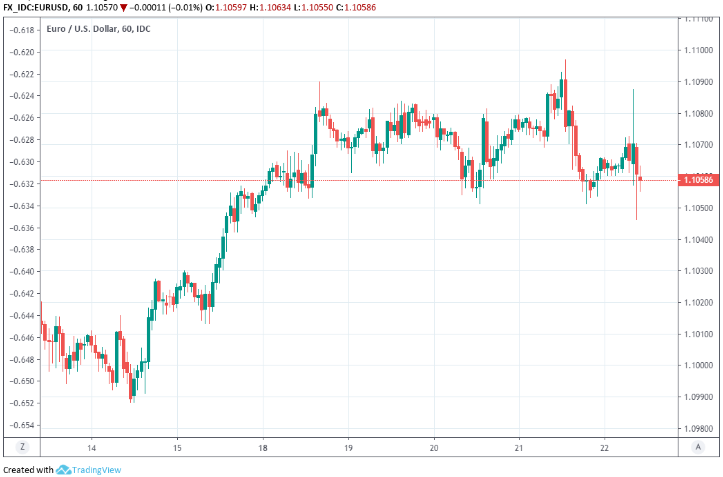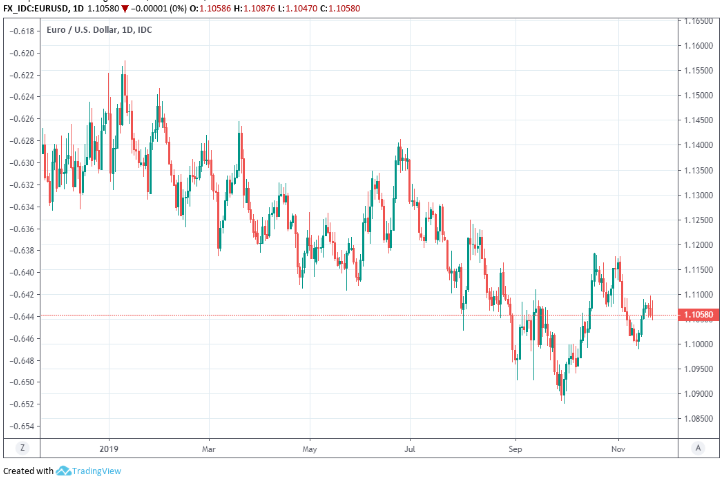Euro-Dollar Rate Fails to Sustain Gains from Manufacturing PMI Thaw
- Written by: James Skinner

© Adobe Stock
- EUR pops after PMIs surprise on upside, ECB talks policy.
- Eurozone industy still shinking but PMI in second surprise.
- Services surprise on downside but manufacturing is key.
- Industrial recovery could lurk in long grass of next year.
- Lagarde's ECB to carry out 'strategic review' of policy.
- But Friday's Euro upturn will be short-lived, analysts say.
The Euro rose briefly on Friday after IHS Markit surveys offered fresh hope that a manufacturing recovery is on the way and after European Central Bank (ECB) chief Christine Lagarde promised a review of its policy although some still see the single currency remaining heavy in the weeks ahead.
November's Eurozone manufacturing PMI clocked in at 46.6, up from 45.9 and slightly ahead of the consensus for a reading of 46.4, with gains driven mostly by the barometer for Germany. The German PMI rose from 42.1 to 43.8 in November when markets were looking for it to rise only as far as 42.9.
However, and on the downside, Europe's services PMI missed expectations by some distance when it fell from an upwardly-revised 52.2 to just 51.5 this month. That's its lowest level since December 2018, when markets had looked for a reading of 52.4. The downward movement in the services barometer was again driven by Germany, where the PMI fell from 51.6 to 51.3 while markets were looking for an increase to 52.0.
"The German economy is still stuck in the mud according to the PMIs, despite GDP growth rebounding slightly in the third quarter. The manufacturing index rose slightly, but it remains depressed at just 43.8, and the services index also appears to be stabilising at a somewhat weaker level," says Claus Vistesen, chief Eurozone economist at Pantheon Macroeconomics. "What’s more positive, though, is that firms' expectations for production one year out flipped to net positive for the first time in four months."
Europe's services numbers were a disappointment for markets and may confirm some economists' earlier suspicions that the manufacturing downturn may spill over into the rest of the economy, although stabilisation in the industrial sector might neuter fears over the likely extent of any damage to the services industry.
Friday's numbers are the second consecutive improvement in the Eurozone PMIs and come hard on the heels of Destatis figures that confirmed Germany's economy dodged a 'technical recession' in the third quarter, with GDP growth of 0.1% following on from the 0.1% contraction seen in the prior period.

Above: Euro-to-Dollar rate shown at hourly intervals. PMI-induced bounce quickly fades.
"After a long inventory drawdown in manufacturing, there are signs of new orders picking up in the survey data that rarely provide a false dawn. It also helps to see auto registrations in Germany picking up after a substantial slowdown," says Jordan Rochester, a strategist at Nomura, in an earlier note to clients. "The positive signs may prove slow to feed through into the overall data or may not be evenly shared. While German auto registrations have moved into positive territory, France and the euro area are lagging slightly."
Friday's figures follow other survey data that showed new manufacturing orders picking up in October, which bodes well for the outlook over the coming quarters. That message was reinforced by industrial production data that showed the downturn in activity abating at the end of the third-quarter.
The figures may suggest that Europe's economy is close to finding a base after a year-long downturn prompted by the U.S.-China trade war, uncertainty over the outcome of the Brexit process and new EU rules that caused significant disruption to production from the automotive sector.
"It is still unlikely to convince markets that a tangible recovery is on the cards. In turn, we think the euro could face some upside pressure today, but will still be capped in coming weeks as uncertainty on the outlook persists. EUR/USD can break the 1.1087 100-day moving average and advance towards the 1.11 level, which should however prove to be a more solid resistance," says Chris Turner, head of FX strategy at ING, in a research note ahead of the release.
The IHS Markit surveys were released around the same time that new ECB chief and former International Monetary Fund (IMF) boss Christine Lagarde addressed the European Banking Conference, where she told her audience the bank will carry out a 'strategic review' of its monetary policy.
This is after the September decision of former boss Mario Draghi's Governing Council, to cut the deposit rate from -0.4% to -0.5% and restart 'quantitative easing' bond purchases, caused signficicant division in the corridors of the Frankfurt-based institution.

Above: Euro-to-Dollar rate shown at daily intervals.
September's measures were dismissed by some economists as insufficient to get the Eurozone firing on all cylinders, leading to questions of whether they're worth it given how the ECB has all but run out of monetary bullets it can use to fight further economic shocks with.
"We think completion of a European Banking Union, the fiscal policy stance and the EUR outlook are all intertwined," says Stephen Gallo, European head of FX strategy at BMO Capital Markets. "We currently foresee only slight upside risks to the EUR from looser fiscal policy next year and we have serious reservations about the extent to which recent developments on Banking Union can feed through to a much stronger EUR."
The ECB has been buying up significant amounts of government bonds and cutting rates for years in the hope of lifting economic growth to levels that will sustainably deliver the "close to, but below 2%" inflation target.
But after many false dawns, inflation remains close to where it was in January 2015 when the bank announced its first foray into the bond market and many now see the ECB as being close to if-not already at the 'reversal rate' where further stimulus just does more harm than good.

Above: Euro-to-Dollar rate shown at weekly intervals.
Limited room for maneuver on the monetary field saw Mario Draghi implore Eurozone governments during his final months to step in with more spending and investment in order to get the economy moving faster, which was interpreted by some as an admission the bank has done all it is able to do.
Lagarde reiterated those pleas Friday and called for more Eurozone integration, beginning with a 'banking union', a 'capital markets union', a 'digital single market' and a 'single market in services'. Integration has long been held up by European politicians as a kind of panacea for the Eurozone's problems. Economists themselves say further integration would help address the Eurozone's structural problems and that it could lift 'potential growth', although such views are almost always long-term in nature.
"A new spirit of optimism! The EZ economy appears to be on the road to recovery and may continue to gain momentum over the coming weeks, provided the trade conflict doesn't intensify. However, the current environment remains a breeding ground for additional uncertainties....the euro has been relatively resilient for weeks, yet there is a lack of arguments to justify a sustained upward trend," says Marc-Andre Fongern, a strategist at MAF Global Forex.
Time to move your money? Get 3-5% more currency than your bank would offer by using the services of a foreign exchange specialist. A specialist payments provider can deliver you an exchange rate closer to the real market rate than your bank would, thereby saving you substantial quantities of currency. Find out more here.
* Advertisement




